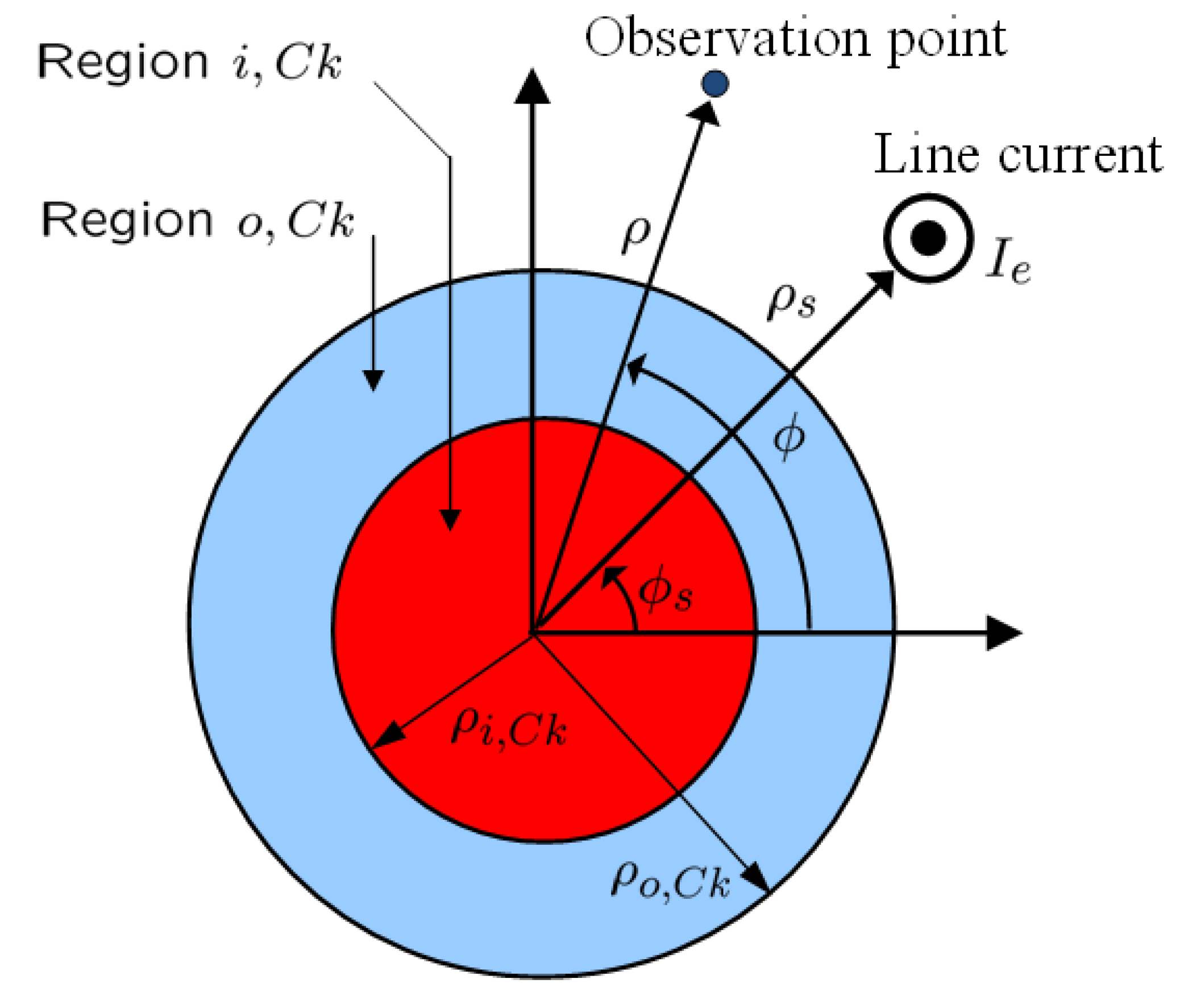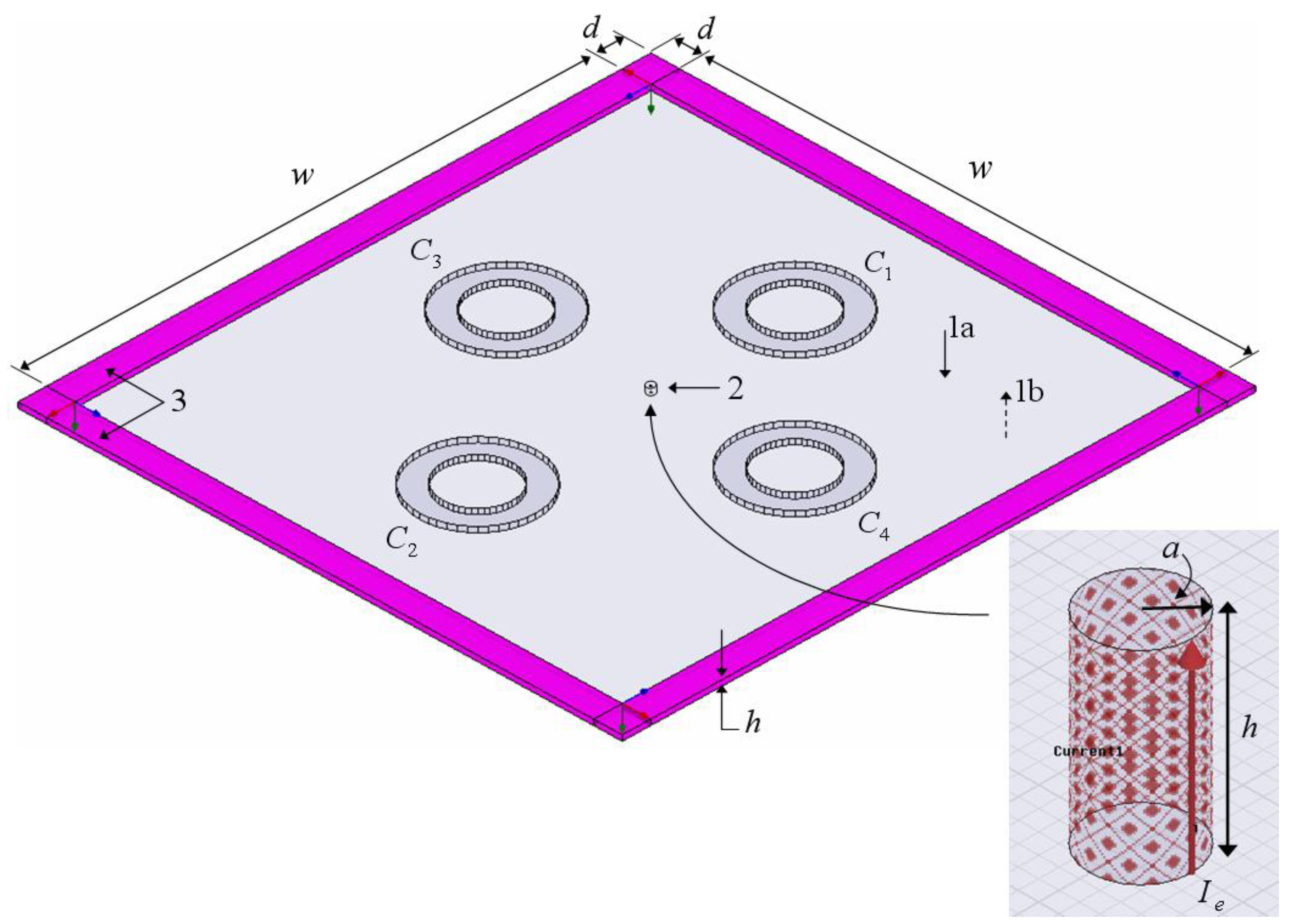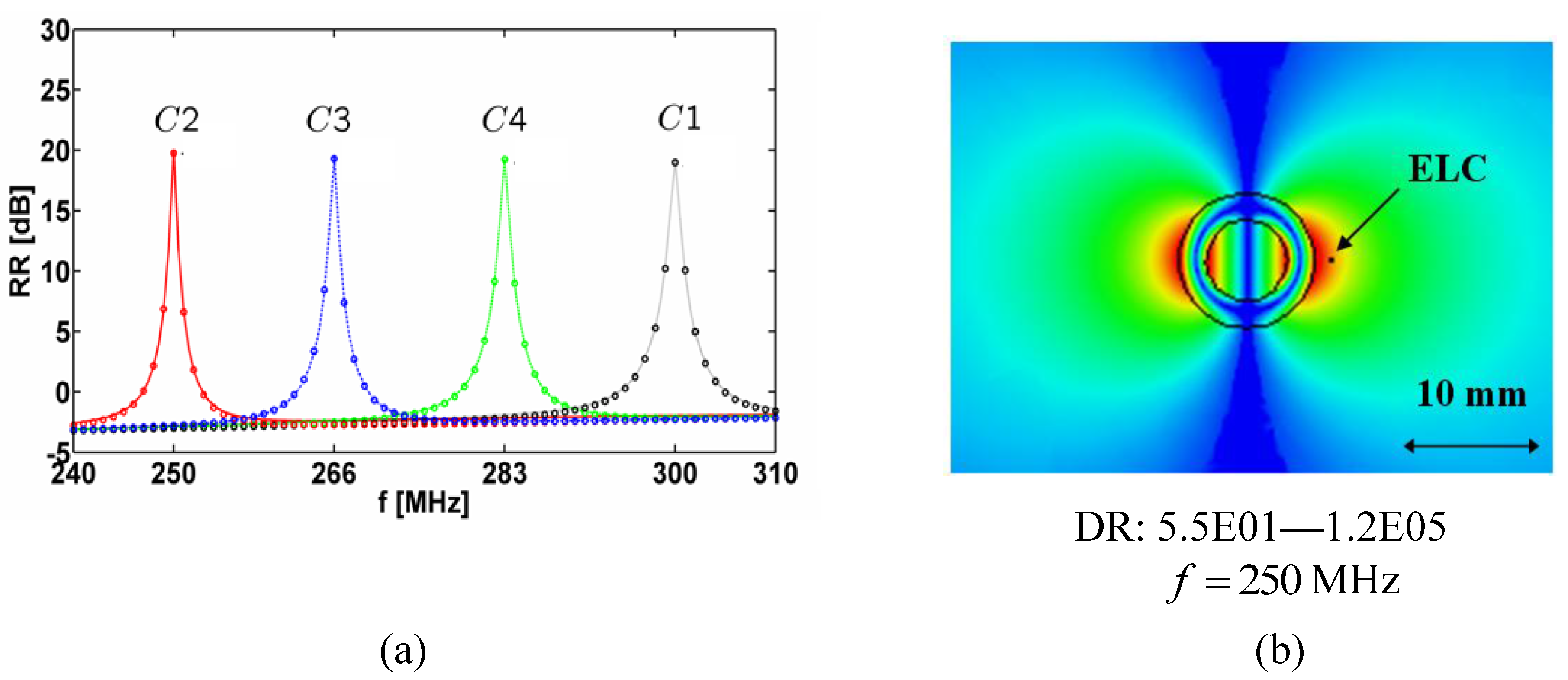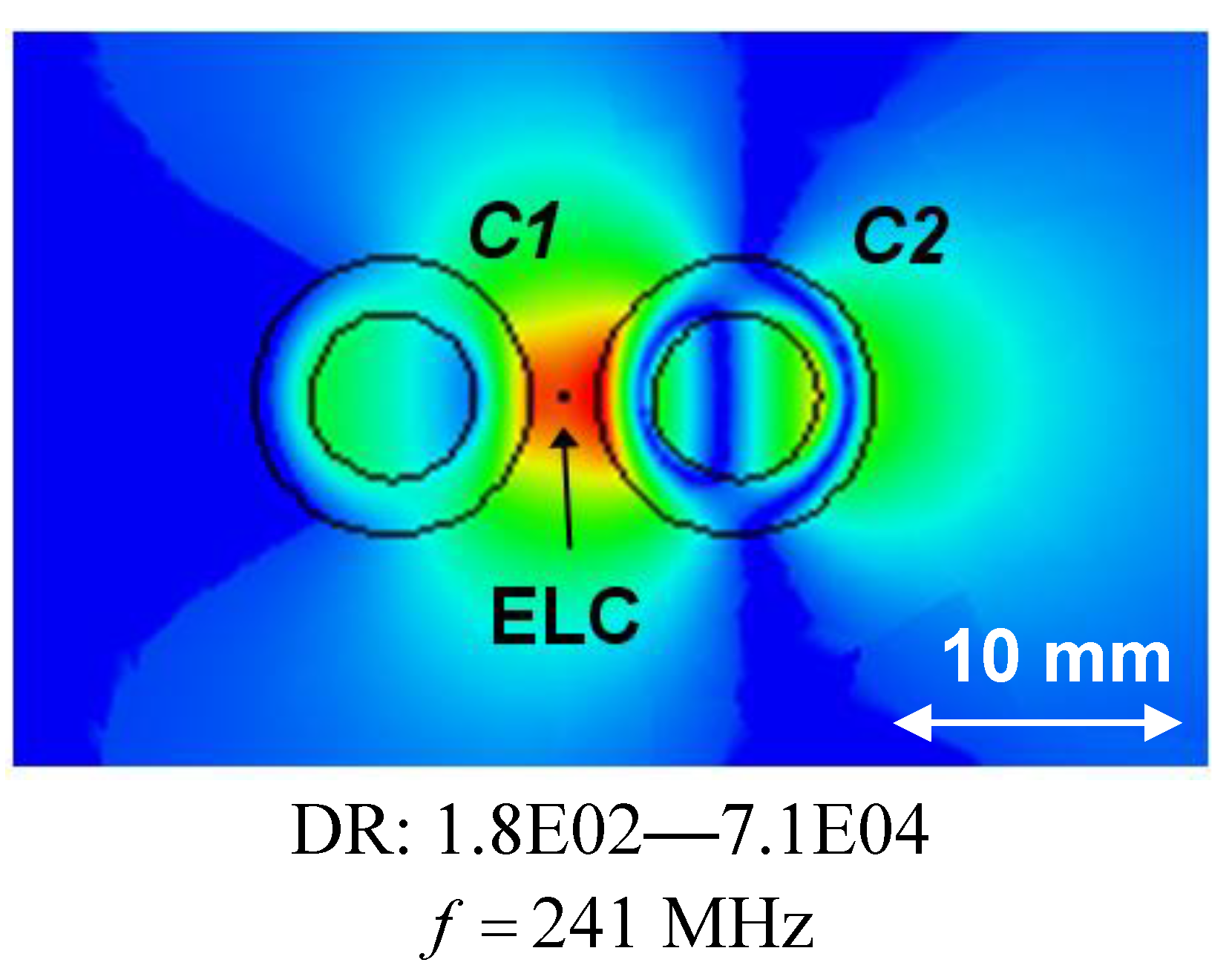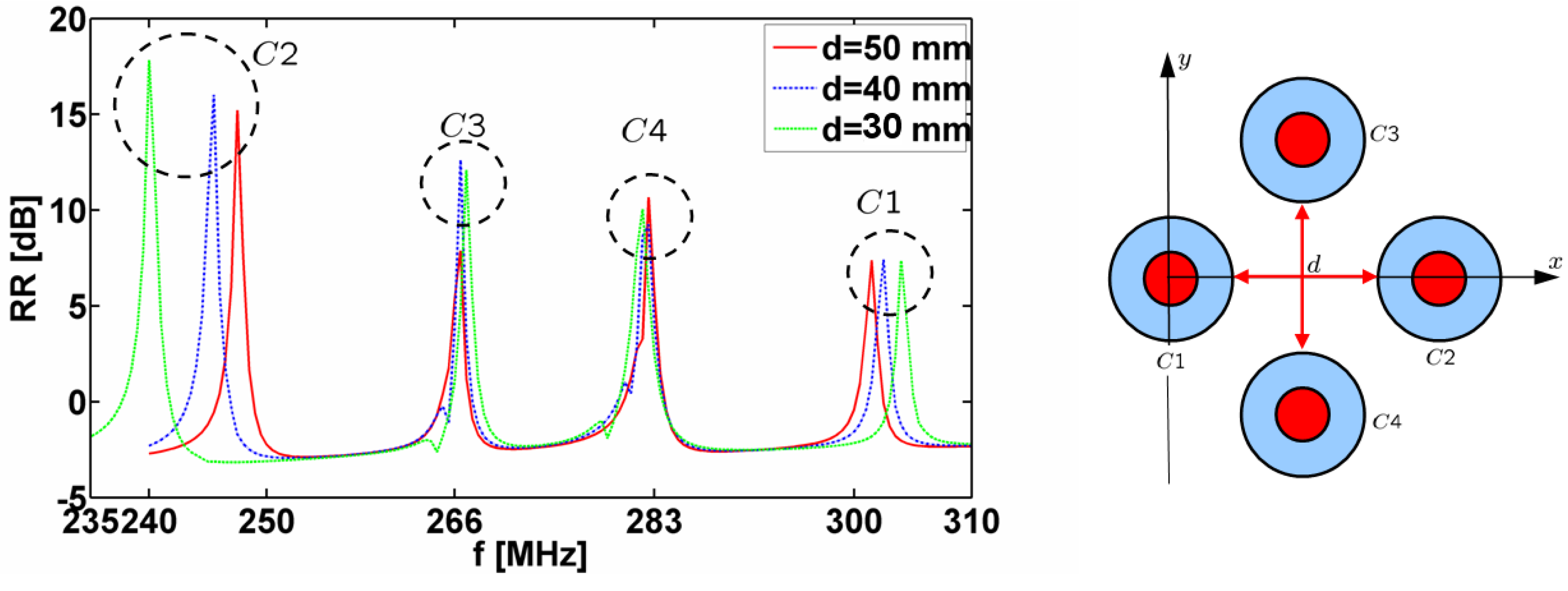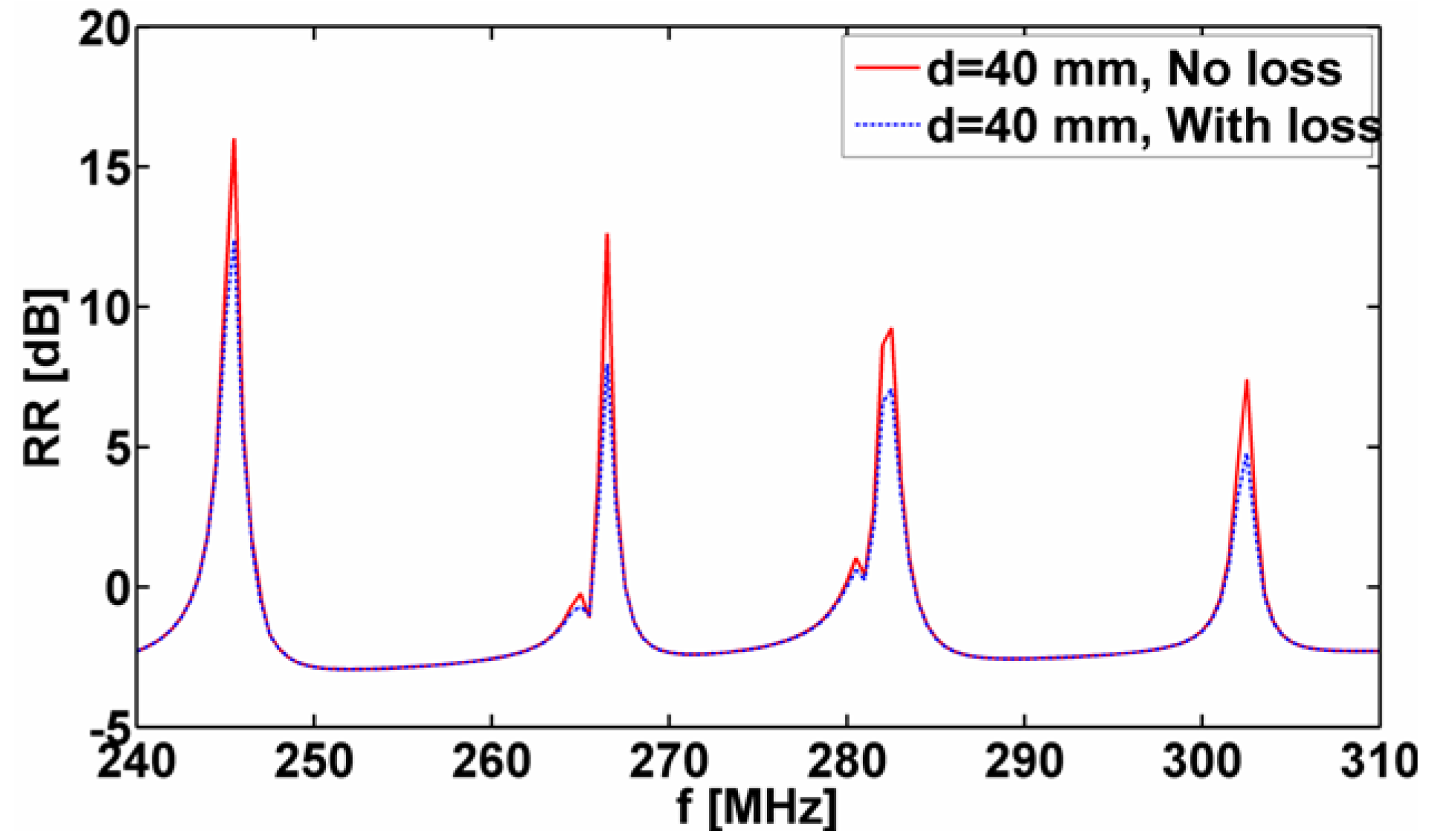3.1. Resonant Configurations and Further Remarks on the HFSS Model
According to
Section 2.3 and [
6,
9], it is possible to design a sub-wavelength 1-cylinder structure capable of exciting a dipole (
n = 1) mode resonance, which leads to large values of, e.g., radiated power and radiation resistance. In the present section, we investigate whether these resonances of the individual 1-cylinder structures exist, and under which conditions when several cylindrical structures are grouped to form a new structure. To this end, we choose the individual 1-cylinder configurations which excite the dipole resonances at the design frequencies
MHz for cylinders
C2,
C3,
C4 and
C1, respectively, this leading to the smallest free-space wavelength
m. The excitation of the dipole mode at the specified design frequencies can be accomplished if region
is free space,
i.e.,
, region
is a MNG material with
, and
mm, while
mm,
mm,
mm, and
mm. The values for
are the exact values of the outer radii of the respective shells of the individual 1-cylinder structures of which the electrical and geometrical parameters are summarized in
Table 1.
Table 1.
Electrical and geometrical parameters of dipolar 1-cylinder configurations.
Table 1.
Electrical and geometrical parameters of dipolar 1-cylinder configurations.
| Cylinder CK | f [MHz] | ρo,Ck [mm] |
|---|
| C1 | 300 | 10.033 |
| C2 | 250 | 10.024 |
| C3 | 266 | 10.027 |
| C4 | 283 | 10.03 |
For all structures:
; ; mm |
In all cases, the current of the line source, in the exact as well as the HFSS-based examinations, is set to
Ie = 1 A. For the HFSS model, the ELC is modeled by a perfectly conducting tube of radius
; the side length of the square circumscribed by the uniform perfect matching layers is
; the separation between the perfectly conducting plates is
, and the thickness of the perfectly matching layers is set to
(the latter being the default value suggested by HFSS for the chosen value of
w). The model of the ELC was tested thoroughly by comparing the numerically calculated radiation resistance in free space with the known analytical result. With the current along the tube being equal to
Ie = 1 A, the radiation resistance as calculated by HFSS was found to be 0.57 Ω/mm; a value which is very close to the exact analytical result of 0.59 Ω/mm[
12], thereby verifying the established HFSS model of the ELC.
In order to assess the frequency behavior of the MNG material of the 1-, 2-, and 4-cylinder structures, the Drude dispersion model [
3] has been employed for the permeability
of region
for all configurations. In (6), the quantity
is the magnetic plasma frequency, and is chosen such that
is obtained at the respective design frequencies. The parameter
is the magnetic collision frequency representing losses in the material.
3.2. 1-Cylinder Structure
The resonances of the 1-cylinder structures are illustrated in
Figure 3(a) where the quantity
[dB], where the radiation resistance
Rt (1) has been normalized by 1 Ω/mm, is shown as a function of frequency when each of the cylinders is centered at the origin and the ELC is located at
. The permeability of the MNG shell of all configurations is modeled by the lossless Drude model for which
in all structures. The circles in
Figure 3(a) represent the exact analytical results while the full lines represent the corresponding HFSS results. The agreement between the exact analytical results and HFSS results is seen to be excellent; a similar agreement was reported in [
13]. It is clear that the individual 1-cylinder structures resonate at the desired designed frequencies; moreover, the values of RR are comparable in the four cases and equal to approximately 20 dB, this showing large enhancements of the radiation resistance of the ELC nearby the MTM-based structures relative to the case where the ELC is alone in free space.
Figure 3(b) shows the magnitude of the electric field in the -plane (with the dynamic range (DR) indicated below the figure) of the resonant (MHz) 1-cylinder structure at the frequency
f =250 MHz (similar electric field results are obtained for other 1-cylinder structures and are therefore not presently included). A clear dipole electric field patter is observed in
Figure 3(b), confirming that the resonances in
Figure 3(a) are due to the excitation of the dipole mode in the individual cylinders.
It is next investigated how the resonances of the individual 1-cylinder structures reported in
Figure 3 are affected when several structures are grouped to form 2- and 4-cylinder structures.
Figure 3.
The quantity [dB] as a function of frequency for the resonant 1-cylinder structures (a), and the magnitude of the electric field of the resonant C2 (250 MHz) 1-cylinder structure for f = 250 MHz (b). In all cases, each of the individual cylinders are centered at the origin and the ELC is located at . The electric field in (b) is depicted in the -plane and the linear dynamic range (DR) in V/m is indicated below the figure. Curves representing the circular surfaces of the structure and a left-right arrow, indicating the size scale of the figure, are likewise indicated in (b).
Figure 3.
The quantity [dB] as a function of frequency for the resonant 1-cylinder structures (a), and the magnitude of the electric field of the resonant C2 (250 MHz) 1-cylinder structure for f = 250 MHz (b). In all cases, each of the individual cylinders are centered at the origin and the ELC is located at . The electric field in (b) is depicted in the -plane and the linear dynamic range (DR) in V/m is indicated below the figure. Curves representing the circular surfaces of the structure and a left-right arrow, indicating the size scale of the figure, are likewise indicated in (b).
3.3. 2-Cylinder Structure
Figure 4 shows the results for the 2-cylinder structure consisting of cylinders
C1 and
C2 (the structure is shown in the inset on top of the figure). Specifically,
Figure 4(a) and
Figure 4(b) show the quantity RR [dB] as a function of frequency for the separation distances
d = 50, 40, 30, 20, 10 and 5 mm with the ELC located at
. For all separation distances
d, two distinct resonances are found. For
d = 50 and 40 mm, the resonances occur at
f = 250 MHz and
f = 300 MHz, respectively, where the individual cylinders are designed to resonate and their amplitudes are seen to be lower than for the individual cylinders in
Figure 3(a), since the ELC is farther away from the cylinders in the present cases. These resonances are due to the dipole mode excitation in the cylinders, as illustrated in
Figure 4(c) and (d) where the magnitude of the electric field is shown for
d = 40 mm and
f = 250 MHz in (c) and
f = 300 MHz in (d). As the separation distance
d decreases further, one and/or both resonances shift slightly away from the resonant frequencies of the isolated individual cylinders. However, these resonances are still due to the dipole modes in the two cylinders. This is, however, not the case for the separation distance of
d = 5 mm where, e.g., the first resonance at
f = 241 MHz, which attains higher amplitude than in the case of individual cylinders, is due to a mode characterized by strong coupling between the two cylinders as is illustrated in
Figure 5 where the magnitude of the electric field is shown. With the diameter of the individual cylinders being approximately 20 mm, it is thus found that the sub-wavelength resonances of the individual cylinders also occur in 2-cylinder configurations of which the overall size is as small as
(for
d = 10 mm), thus proving such structures feasible for the potential design of multi-resonant sub-wavelength systems.
Figure 4.
(a) and (b): The quantity [dB] as a function of frequency for the resonant 2-cylinder structures for different separation distances d. The magnitude of the electric field of the resonant 2-cylinder structures for d = 40 mm and f = 250 MHz; (c) and f = 300 MHz (d). In all cases, the ELC is located at . The electric field in (c) and (d) is depicted in the xy-plane and the linear dynamic range (DR) in V/m is indicated below the figures. Curves representing the circular surfaces of the structure and a left-right arrow, indicating the size scale of the figure, are likewise shown in (c) and (d). Inset above the figure shows the 2-cylinder structure consisting of cylinders C1 and C2.
Figure 4.
(a) and (b): The quantity [dB] as a function of frequency for the resonant 2-cylinder structures for different separation distances d. The magnitude of the electric field of the resonant 2-cylinder structures for d = 40 mm and f = 250 MHz; (c) and f = 300 MHz (d). In all cases, the ELC is located at . The electric field in (c) and (d) is depicted in the xy-plane and the linear dynamic range (DR) in V/m is indicated below the figures. Curves representing the circular surfaces of the structure and a left-right arrow, indicating the size scale of the figure, are likewise shown in (c) and (d). Inset above the figure shows the 2-cylinder structure consisting of cylinders C1 and C2.
Figure 5.
The magnitude of the electric field of the resonant 2-cylinder structure when the separation distance
d = 5 mm for
f = 250 MHz, which is the frequency at which the first resonance appears in
Figure 4(b). The ELC is located at
, and the electric field is depicted in the
xy-plane with the linear dynamic range (DR) in V/m indicated below the figure. Curves representing the circular surfaces of the structure and a left-right arrow, indicating the size scale of the figure, are likewise indicated.
Figure 5.
The magnitude of the electric field of the resonant 2-cylinder structure when the separation distance
d = 5 mm for
f = 250 MHz, which is the frequency at which the first resonance appears in
Figure 4(b). The ELC is located at
, and the electric field is depicted in the
xy-plane with the linear dynamic range (DR) in V/m indicated below the figure. Curves representing the circular surfaces of the structure and a left-right arrow, indicating the size scale of the figure, are likewise indicated.
3.4. 4-Cylinder Structure
Figure 6 shows the results for the 4-cylinder structure (the structure itself is shown in the inset in the right part of the figure).
Figure 6.
The quantity [dB] as a function of frequency for the resonant 4-cylinder structures for different separation distances d. In all cases, the ELC is located at . The 4-cylinder structure is shown on the right.
Figure 6.
The quantity [dB] as a function of frequency for the resonant 4-cylinder structures for different separation distances d. In all cases, the ELC is located at . The 4-cylinder structure is shown on the right.
Specifically,
Figure 6 shows the quantity
[dB] as a function of frequency for the separation distances
d = 50, 40, and 30 mm when the ELC is located at
. For all separation distances
d, four distinct resonances are found, although slightly shifted from the resonant frequencies of the individual cylinders and with lower amplitudes than in the case of the 1-cylinder structures in
Figure 3(a). For a given separation
d, this shift is larger for the 4-cylinder than for the 2-cylinder configuration and is seen to be largest for the cylinders
C1 and
C2. The majority of the resonances in
Figure 6 are due to the dipole mode excitation in the individual cylinders; this is clear from
Figure 7(a)–(d), which show the magnitude of the electric field (with the dynamic range (DR) indicated below the respective figures) for
d = 40 mm for the frequencies at which the resonances appear in
Figure 6 (
f = 245.5, 266.5, 282.5, and 302.5 MHz).
The corresponding fields at the resonant frequencies of the isolated individual cylinders are shown in
Figure 7(e)–(h); these also show clear dipole patterns but with different maximum values of the field. While the field levels for the cylinders
C3 and
C4, respectively, in
Figure 7(b) and (c) are comparable with those in
Figure 7(f) and (g), they are at least an order of magnitude lower for cylinders
C2 and
C1, respectively, in
Figure 7(a) and (d), as compared to
Figure 7(e) and (h). This explains why, e.g., large RR values are attained for cylinders
C3 and
C4 not only at the frequencies
f = 266.5 MHz and 282.5 MHz, respectively, but also at the original resonance frequencies of the individual cylinders, whereas this is found not to be the case for cylinders
C2 and
C1. Moreover, for the separation distance of
d = 30 mm, the first resonance occurring at
f = 240 MHz is not due to a clear dipole mode in the cylinder
C2, but rather to a mode which is due to coupling effects between the four cylinders, as is clearly illustrated by the result in
Figure 8, which shows the magnitude of the electric field in this particular case. With the diameter of the individual cylinders being approximately 20 mm, it is thus found that the sub-wavelength resonances of the individual cylinders also occur in 4-cylinder configurations of which the overall size is as small as
(for
d = 40 mm), thus proving such structures feasible for the potential design of multi-resonant sub-wavelength systems.
It is noted that if the individual cylinders are designed such that their resonances are even closer to each other, the coupling becomes more visible than in the case of the presently investigated cylinders. This is supported by the results in
Figure 3(a) which suggests that for close enough resonance frequencies, the radiation resistance curves (those parts with significant values of the radiation resistance) for the individual cylinders will considerably overlap each other thus indicating a stronger coupling.
Figure 7.
The magnitude of the electric field of the 4-cylinder structure for the separation distance
d = 40 mm for different frequencies. The ELC is located at
, and the electric field is depicted in the
xy-plane with the linear dynamic range (DR) in V/m indicated below the figure. Curves representing the circular surfaces of the structure and a left-right arrow indicating the size scale of the figure, are likewise indicated. (
a)–(
d): frequencies at which the resonances occur in
Figure 6; (
e)–(
h): initial resonance frequencies of the individual structures.
Figure 7.
The magnitude of the electric field of the 4-cylinder structure for the separation distance
d = 40 mm for different frequencies. The ELC is located at
, and the electric field is depicted in the
xy-plane with the linear dynamic range (DR) in V/m indicated below the figure. Curves representing the circular surfaces of the structure and a left-right arrow indicating the size scale of the figure, are likewise indicated. (
a)–(
d): frequencies at which the resonances occur in
Figure 6; (
e)–(
h): initial resonance frequencies of the individual structures.
Figure 8.
The magnitude of the electric field of the 4-cylinder structure for the separation distance
d = 30 mm and
f = 240 MHz; this is the frequency at which the first resonance appears in
Figure 6. The ELC is located at
, and the electric field is depicted in the
xy-plane with the linear dynamic range (DR) in V/m indicated below the figure. Curves representing the circular surfaces of the structure and a left-right arrow, indicating the size scale of the figure, are likewise indicated.
Figure 8.
The magnitude of the electric field of the 4-cylinder structure for the separation distance
d = 30 mm and
f = 240 MHz; this is the frequency at which the first resonance appears in
Figure 6. The ELC is located at
, and the electric field is depicted in the
xy-plane with the linear dynamic range (DR) in V/m indicated below the figure. Curves representing the circular surfaces of the structure and a left-right arrow, indicating the size scale of the figure, are likewise indicated.
The analysis thus far has concentrated on the cases where the MNG material of the 1-, 2-. and 4-cylinder structures was modeled by a lossless Drude dispersion model for which
. Presently, the influence of loss on the reported resonant properties of these structures is assessed by incorporating loss in the model. More specifically, the parameter
was set to
, where
f0 is the design frequency of the respective cylinders, and the radiation resistance was for the 4-cylinder configuration with the separation distance
d = 40 mm. The obtained results are reported in
Figure 9 in terms of the quantity
[dB] as a function of frequency. This figure also includes the corresponding lossless-case result for comparison purposes. It is observed that resonances occur at the same frequencies as in the lossless case, but that the corresponding amplitudes, as expected, are reduced.
Figure 9.
The quantity [dB] as a function of frequency for the lossy and lossless 4-cylinder structures for separation distance d = 40 mm. In all cases, the ELC is located at . See the main text for further explanations.
Figure 9.
The quantity [dB] as a function of frequency for the lossy and lossless 4-cylinder structures for separation distance d = 40 mm. In all cases, the ELC is located at . See the main text for further explanations.
